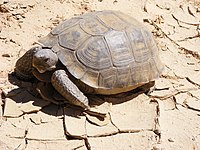
Photo from wikipedia
Abstract Pathogens that cause subclinical diseases or exhibit low infection intensities are difficult to quantify in wild populations. Mojave desert tortoises (Gopherus agassizii) have been the focus of much research… Click to show full abstract
Abstract Pathogens that cause subclinical diseases or exhibit low infection intensities are difficult to quantify in wild populations. Mojave desert tortoises (Gopherus agassizii) have been the focus of much research aimed at measuring the presence of upper respiratory disease (URTD) and URTD-associated pathogens, and techniques used to quantify disease in Gopherus species have also been used for disease surveillance in other species of turtles and tortoises of conservation concern. Published surveys of G. agassizii populations have found a relatively low prevalence of URTD, with most URTD-positive animals exhibiting moderate, intermittent signs of morbidity. Therefore, multiple tests have been developed to quantify URTD including genetic detection of the pathogens Mycoplasma agassizii and Mycoplasma testudineum, detection of M. agassizii-specific antibodies, and standardized quantification of clinical signs of URTD and body condition. These diagnostic tests have only been compared in diseased or moribund, semicaptive animals. We compared diagnostic techniques (TaqMan® and SYBR™ Green qPCR, serology, and visible examination) to detect M. agassizii-associated URTD in 126 wild desert tortoises sampled in Nevada and California, US in 2010. All had healthy body condition indices and none exhibited more than mild-to-moderate visual signs of URTD. Pairwise comparisons of diagnostic techniques indicated poor performance in diagnosing disease in individual animals. We found stronger, but inconsistent, statistical associations among diagnostic techniques at the population level. Our findings have implications for quantifying subclinical respiratory disease in tortoises.
Journal Title: Journal of Wildlife Diseases
Year Published: 2017
Link to full text (if available)
Share on Social Media: Sign Up to like & get
recommendations!